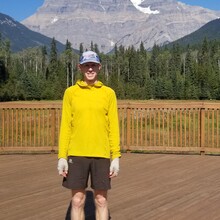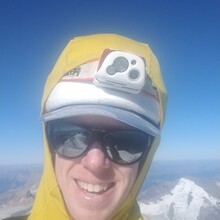"Quantity has a quality all its own." The South Face of Robson, at one point the voie normale on the King of the Rockies, is now sometimes viewed as a chossy, dangerous route that is not worth doing.
But what it might lack in aesthetic climbing it more than makes up for in sheer quantity of climbing, rising 3,000 vertical meters from Kinney Lake to the highest summit in the Canadian Rockies. Plus, the steep snow climbing on the direct finish, leading climbers in a straight line to the summit, is absolutely fantastic, cementing the South Face route as a classic of the Canadian Rockies.
When I moved to the Rockies I made a ticklist of routes I wanted to climb in a light, fast style. Robson was one of the last routes on my list but for years I was too intimidated to try. Yet season after season I gained experience, fitness, and confidence, finally reaching the point where this year I felt ready to make an attempt. I had not previously been on Robson's South Face but after carefully studying the route, talking to friends who had done it, and with the gpx track, it seemed routefinding would not be too difficult.
I set out on my bike a little after 5am with the goal of arriving at the base of the face at sunrise. Leaving the bike locked to a tree, I settled into a good, steady pace up surprisingly steep forested slopes. I arrived at the Ralph Forster hut in about 2 hours 15 minutes from the parking lot. Here I ate a gel, stowed my poles in my pack, and continued on to nearly the top of Little Robson. Confronted with an icy section I was forced to switch to mountain boots and crampons.
I needed the crampons again to cross some ice on the Schwarz Ledges and then again for the steep summit glacier. I used 2 light ice tools for the final climb to the summit and was glad to have both as the snow was quite firm and icy.
I arrived at the summit in 4:55 elapsed time, still wearing just running shorts and a sun hoody. It was an absolutely perfect day and, unbelievably, I had the entire mountain to myself. Despite the warm weather, the snow remained firm from a solid overnight freeze, allowing for good cramponing and tool placements.
After taking in the views and eating another gel, I began my descent. I wanted to be below the Scwharz Ledges before noon as I feared the seracs could become more active in the afternoon heat. I downclimbed face-in for most of the upper mountain. I was wearing fingerless UV gloves and my knuckles were bleeding from swinging the tools on ascent. While slightly painful, this had the unexpected benefit of leaving a red breadcrumb trail on the snow, which proved quite useful for routefinding on descent. After what felt like endless downclimbing, the angle finally eased and I turned around and jogged down the remaining snow, heal plunging for the last bit to the ledges.
I took a better route across the ledges than I had on ascent, managing to stay mostly clear of the seracs until I reached a good sidewalk ledge that ushered me quickly across the icy crux and onward to safety. I think I spent less than 2 minutes exposed to the worst section of overhead seracs.
From here, it was simply a matter of staying on route and carefully descending exposed, never-ending choss. When I reached the steep forest I finally felt I could start running again and descended quickly back to my bike. A pleasant twenty minute cruise to the trailhead and it was done, a dream come true.
For gear, I wore:
Sub-200g running shoes
Socks
Running shorts
Sun hoody
Sun gloves
Baseball hat
Helmet
Headlamp
Trekking poles
I carried:
15L run vest
Inreach
Cell phone
Emergency bivy
Athletic tape
Light synthetic puffy jacket
Light down puffy jacket
Ultralight rain jacket
Wind jacket
Mid weight base layer top
Windproof winter running tights
Toque
Buff
Ice climbing gloves
Three season mountaineering boots
Hybrid crampons
Spare crampon toe bail and cord-tec cord
2 ice tools
Glacier glasses
Sunblock
Spf lip balm
Nutrition
3 500ml flasks
6 x Maurten 320 CAF 100
3 x Maurten 160 gel
1 x Maurten 100 gel
Total calories 2,500 or about 70 grams of carbohydrate per hour.
Safety Considerations
With no rope I was committed to downclimbing the steep snow on the upper mountain. I brought spare crampon parts so I could repair a crampon should something break. I also knew I could downclimb the route with one ice tool if I dropped one, and could probably even manage with just one crampon by chopping steps. Taking into account the weather forecast, snow conditions, my climbing experience and risk-tolerance, this was a big enough margin of safety to leave the rope behind.
Robson felt like a big serious mountain so I brought more warm clothes than I normally would on a speed attempt. I wanted to have enough layers to survive a night high on the mountain should something unexpected happen.
For comms I carried an Inreach and cell phone which had some reception on the upper mountain.
I generally support taking some additional risk on speed climbs, by carrying less emergency gear. But Robson warrants a higher level of respect. It's a very big mountain, it's unlikely anyone else will be on it, there is no easy way off, and the weather can change very quickly on the upper mountain.
Soloing Mount Robson was an unbelievable experience, one I will always cherish.


